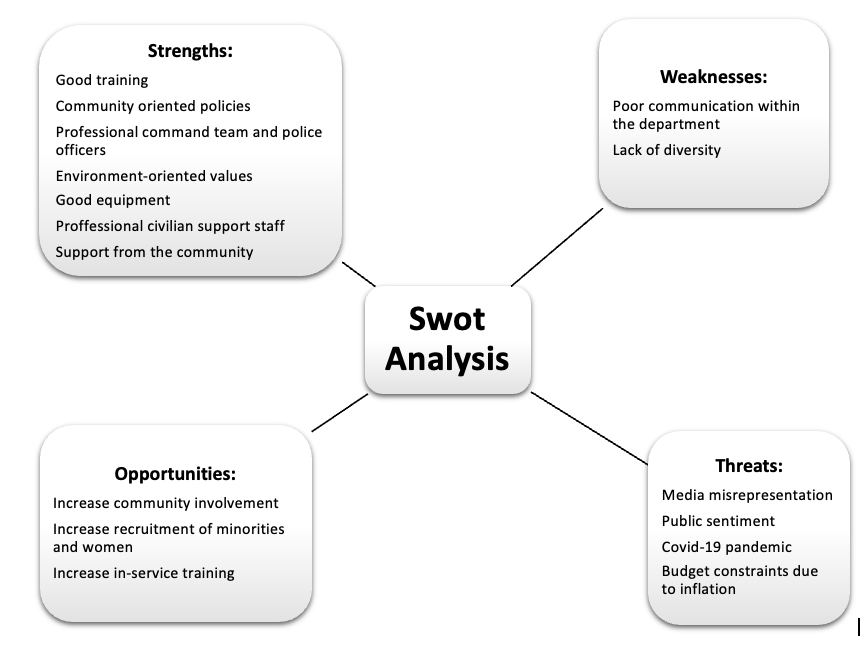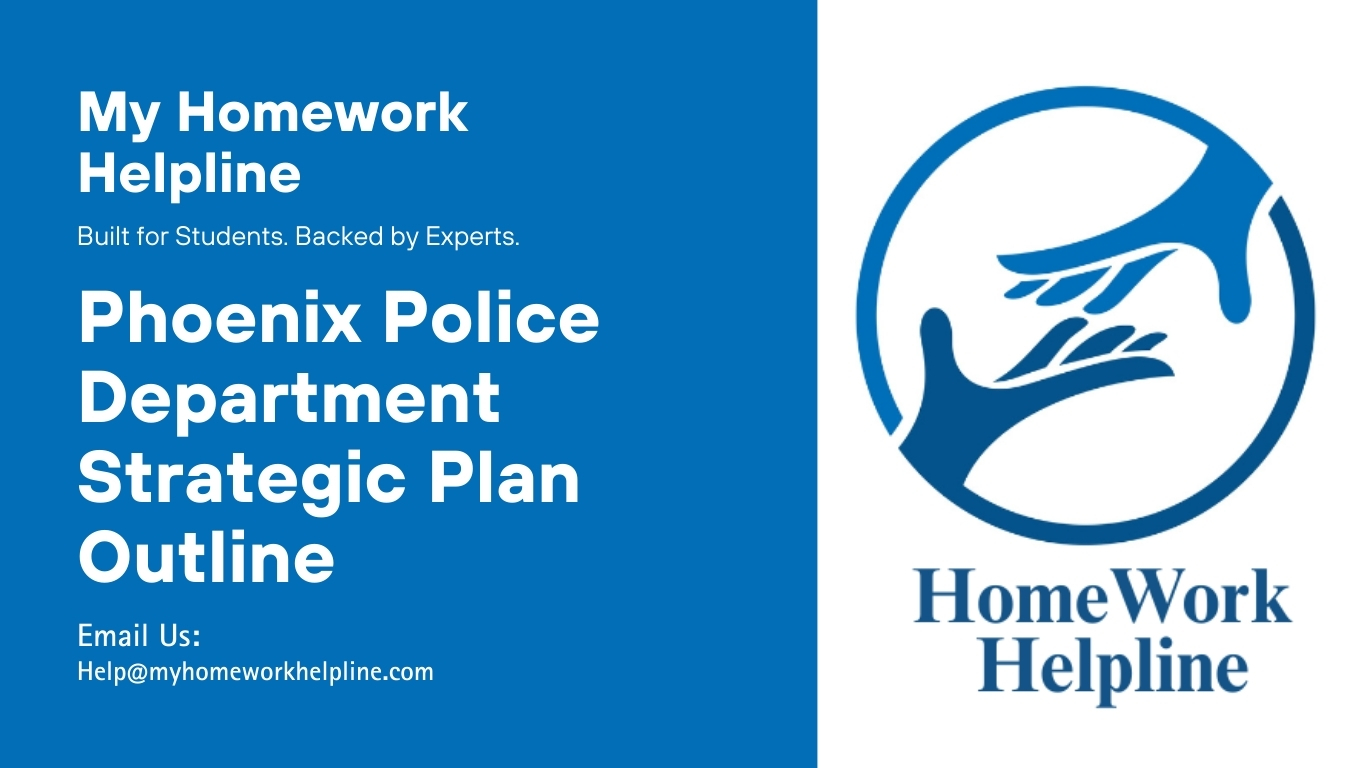Phoenix Police Department Strategic Plan Outline: Mission and Stakeholders
Phoenix Police Department (PPD) is the law enforcement agency in charge of the city of Phoenix, Arizona. The Phoenix Police Department currently serves as Arizona’s largest law enforcement agency. Therefore, this paper aims to create a strategic plan for the Phoenix Police Department. Furthermore, the paper will highlight the critical shortcomings of the agency and include an outline of the strategic plan’s development process, which will serve as the strategic plan’s foundation.
SWOT Analysis Diagram

Suggested Actions or Changes
- Enhance communication and involvement of team members and stakeholders
- Promote diversity during the recruitment
- Increase funding sources and minimize expenditures
- Implement health-safety measures
- Enhance transparency and accountability within the department (Hu et al., 2014)
Stakeholders
- Internal Stakeholders, according to Burke (2019), include:
Police officers
- Police officers are responsible for various tasks, such as ensuring public safety, maintaining accurate records, and testifying in court against alleged criminals. Typical law enforcement responsibilities of police officers include observing a suspect’s activity, patrolling in assigned areas, arresting suspected law violators, conducting traffic stops, and preparing court cases.
- The positive aspects for a criminal justice agency of having police officers as stakeholders in the planning process include the ability to enhance the agency’s law enforcement, crime prevention and control, and assurance of public safety.
Judges
- Judges preside over court cases by reinforcing the law and supervising the legal process. They also settle disagreements and help conflicting parties reach an agreement. Furthermore, they oversee the fair hearing and ruling of a court case by determining the innocence or guilt of the accused and sentencing criminals.
- Involving judges as stakeholders in the planning process of a criminal justice agency is crucial for the agency to reduce crime, reinforce the law, and ensure the fair execution of justice.
Lawyers, including prosecution lawyers and criminal defense lawyers.
- Prosecution lawyers represent the state government and police in prosecuting those accused of a crime. On the other hand, a criminal defense lawyer is responsible for defending individuals accused of committing a crime to protect their rights.
- The positive aspects of a criminal justice agency including lawyers as stakeholders in the planning process include the ability to uphold fundamental freedoms and human rights.
Correctional Officers
- Correctional officers are responsible for rehabilitating offenders through law enforcement and supervising convict activities within a correctional facility.
- Involving correctional officers as stakeholders in a criminal justice agency’s planning process is vital since it promotes the safety of inmates and the transformation of their lives to minimize crime rates.
- External stakeholders, according to Burke (2019), include:
Elected Officials
- Elected officials play a huge role in the criminal justice system by enacting laws, formulating policies, choosing program officials and personnel, determining public safety initiatives, and developing financing decisions that directly and indirectly impact the system.
- Elected officers are essential stakeholders in a criminal justice agency since they formulate relevant policies to guide the agency’s officials while shaping its structure.
Businesses
- Businesses play a vital role in supporting the criminal justice system by funding campaigns to speak out on malpractices.
- As stakeholders, corporations help a criminal justice agency address malpractices and injustices and promote criminal justice reforms.
The Media, including online, print, television, or radio broadcast.
- The media aids in the oversight of federal agencies. The media also serves as society’s overseer, providing details that would otherwise be difficult to obtain.
- The possible benefits for a criminal justice agency of involving the media as a stakeholder in the planning process include conveying the agency’s perspective on issues and reporting incidences of crime to large audiences.
Community
- The Community aids in crime prevention and sustaining a just, peaceful, and secure society by reporting criminals and avoiding crime.
- The Community’s involvement as stakeholders would help the criminal justice agency to execute crime prevention measures effectively.
Advocacy Groups
- Criminal justice advocacy groups contribute to the system by explaining criminal justice procedures, providing resources and research, providing emotional support, referring victims to specific agencies for assistance, and assisting victims in obtaining the necessary information.
- Advocacy groups are significant stakeholders in a criminal justice agency since they help raise awareness and support crime victims.
Timeline of events
Bryson (2018) outlines the following timeline of events during a strategic planning process:
- Planning and preparation (November-December 2022)
- The strategic plan coordinator meets with the county executive and individual board members to discuss a revised strategic plan development process.
- In early December 2022, recommend a revised development process to the Board of County Supervisors (BOCS)
- Convene and train the strategic plan development team and finalize project and community engagement approaches.
- Initial community engagement (January 2023)
- The strategic plan team will finalize online survey questions
- Conduct short online surveys to solicit input on strategic plan focus areas
- Community visioning (January-March 2023)
- BOCS members will host at least one community conversation in each magisterial district to identify strategic priorities
- Strategic plan team members and staff will facilitate virtual community conversations with residents
- Identification of priorities (April-June 2023)
- The strategic plan team will analyze input from survey and community conversations to identify priorities in each focus area
- Facilitate work sessions with BOCS to get input on strategic plan goals
- Development of a strategic plan draft (July-December 2024)
- The strategic team will draft a plan based on community input and BOCS direction with goals, objectives, initiatives, and performance measures.
- BOCS and Community feedback on the strategic plan draft (January 2024)
- Present draft strategic plan to BOCS and Community for review and feedback
- Finalization and adoption of the 2023-2026 strategic plan (February 2024)
- The strategic plan team will finalize the strategic plan based on the feedback from BOCS, Community, and staff
- BOCS adopts the 2023-2026 strategic plan
- Implementation and Reporting (March 2024)
- Create a Strategic Plan Accounting and Reporting Committee (SPARC) to collect data and report on activities
Resources
- Human: Staff, including police officers, detention officers, police assistants, and communications operator
- Monetary: cash balances, other loans, equity, credit lines, and supplier credit agreements
- Physical resources: buildings and facilities, vehicles, communication gadgets, uniforms, stationery, machinery, and equipment
- Technological: software licenses, intellectual property, patents, and copyrights (Bryson, 2018)
Communication Methods
- In-person and virtual meetings will be used to communicate with internal and external stakeholders.
- Emails will be used to communicate with internal and external stakeholders.
- Public service announcements will be used to communicate with external stakeholders
- Video conferences will be used to communicate with internal stakeholders
- Summary reports will be used to communicate with external stakeholders
- Presentations will be used to communicate with internal stakeholders (Schiff, 2013)
Conclusion
As per Hu et al. (2014) study, an effective strategic plan is significant since it helps organizational personnel to comprehend a criminal justice agency’s current and future destination. A successful strategic plan can help top officials agree on efficient organizational strategies. The critical phases in strategic planning include environmental analysis, strategy formulation, execution, and evaluation.
References
Bryson, J. M. (2018). Strategic planning for public and nonprofit organizations: A guide to strengthening and sustaining organizational achievement. John Wiley & Sons.
Burke, A. S., Carter, D., Fedorek, B., Morey, T., Rutz-Burri, L., & Sanchez, S. (2019). 1: Crime, Criminal Justice, and Criminology. SOU-CCJ230 Introduction to the American Criminal Justice System.
Hu, Q., Kapucu, N., & O’Byrne, L. (2014). Strategic planning for community-based small nonprofit organizations: Implementation, benefits, and challenges. Journal of Applied Management and Entrepreneurship, 19(1), 83.
Schiff, M. (2013). Satisfying the needs and interests of stakeholders. In Handbook of restorative justice (pp. 250-268). Willan.

